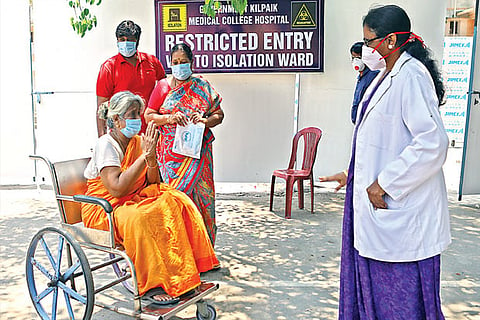

Chennai
Though the government hospitals state that they are adhering to the recommended protocols and reason comorbidities as primary reasons for deaths, several loopholes in the management of COVID-19 cases in the State are being exposed.
The recent death case of a 70-year-old patient, who tested positive on June 9, has highlighted several glitches in the discharge policy. S Muthappa was admitted to Stanley Medical College and Hospital on June 9th after testing positive with mild symptoms of fever. He was treated and sent to institutional quarantine at Pulianthope on June 14.
The patient had co-morbid conditions of diabetes and hypertension. However, he was discharged from the facility and was sent home on June 18th without an exit test as he did not have any symptoms. He was asked to check for sugar levels in a private institution. On being checked and tested, the patient’s chest x-ray revealed about 70 per cent infection in the lungs indicating pneumonia due to COVID-19. He was admitted to the Intensive Care Unit at Stanley Medical College and Hospital on June 20th, where he succumbed to the virus on June 22. While the chief of medicine at Stanley Medical College and Hospital Dr Sridhar and the radiologists say that the death was due to comorbid cardiac conditions and age of the patient, x-ray reports taken on June 19 stated that his heart and pericardium was normal. Coincidentally, the death of a 54-year-old patient from Mannady, who was admitted with COVID-19 to Stanley Medical College and Hospital on May 9, was discharged from hospital on May 19 was strikingly similar. The patient died after developing respiratory issues on May 21.
As per the ICMR guidelines, patients with mild symptoms can be discharged after they have been treated in a hospital for ten days and there is no requirement of an exit test to prove that the patient has recovered. However, these deaths question the protocol that was revised only last month. Meanwhile, public health experts stress the need for monitoring the oxygen level in the blood even after the discharge. Dr Prabhdeep Kaur, deputy director at National Institute of Epidemiology and a member of Tamil Nadu medical expert team, said that the saturation levels need to be monitored every four to six hours, even in case of asymptomatic individuals.
In similar instances, few patients from Rajiv Gandhi Government General Hospital(RGGGH) are getting admitted in private hospitals after being discharged as they continue to face mild symptoms. These patients are unaware of their status as no exit test is being taken and thus, take this test in private laboratories or hospitals.
Intense monitoring: Over 2L homes in city to be quarantined
Over 2 lakh houses in the city will be under home quarantine at any given point of time as the Greater Chennai Corporation has decided to intensify the isolation of potential positive persons and those who are returning from hospitals after recovery.
“We have started implementing the home quarantine monitoring system (HQMS). As on date, around 1.20 lakh houses in the city are under quarantine,” Chennai Corporation Commissioner G Prakash said.
The civic body has listed 18 categories of people to be home quarantined. According to Prakash, residents would be kept under quarantine if they had tested positive and are in home isolation. Also, persons recovered from the infection, home contacts of the positive persons, their extended contact, returnees from other countries, States as well as other districts, symptomatic persons identified at fever clinics will be quarantined. “Such residents should be under home quarantine for 14 days as the possibility of spread is higher. Also, we have appointed 4,500 volunteers, who will help home quarantined persons to buy essential items,” he added. Expressing optimism, Prakash said that the home quarantine monitoring system would control the spread as there would be 2 lakh to 2.5 lakh houses under quarantine at any given point of time. The civic body has also developed an application to track the movement of those quarantined.
Visit news.dtnext.in to explore our interactive epaper!
Download the DT Next app for more exciting features!
Click here for iOS
Click here for Android